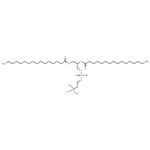Description
DPPC, also known as 1,2-dipalmitoyl-sn-glycero-3-phosphatidylcholine, is a phospholipid containing the 16 carbon fatty acid/palmitic acid (16:0) at the sn-1 and sn-2 positions. It is commonly used in the generation of micelles, liposomes, and other types of artificial membranes. Due to the medium size of fatty acid chain, DLPC is used to form thinner membranes or lipid bilayers.
Chemical Properties
white powder
Uses
16:0 PC (DPPC) is suitable for use:
- in vesicle preparation
- as the main phospholipid component for all ultrasound contrast agents (UCA) formulations
- as a component for microbubble preparation
- in the preparation of lipid bilayers
Uses
16:0 PC (DPPC) has been used in the generation of thymoquinone (TQ) liposomes, gold nanorods and calcium chloride encapsulated liposomes and bilayers for biophysical studies.
Uses
1,2-dipalmitoyl-sn-glycero-3-phosphocholine is a major phospholipid constituent and primary surface tension lowering component of natural lung surfactant. Colfosceril Palmitate is used as pulmonary surfactant and diagnostic aid (fetal lung maturity).
Definition
ChEBI: A phosphatidylcholine 32:0 in which the 1- and 2-acyl groups are specified as hexadecanoyl (palmitoyl). A synthetic phospholipid used in liposomes and lipid bilayers to study biological membranes. It is also a major constituent of pulmonary surfactants.
General Description
Phosphatidylcholine (PC) is a strong bilayer-forming lipid. It the most common phospholipid in mammalian membranes. It is also an important component of the mucosal layer of the colon.
Biochem/physiol Actions
Phosphatidylcholine (PC) functions as a surfactant within the mucus to form a hydrophobic surface to inhibit bacterial penetrance. It is used to treat fat embolism. Phosphatidylcholine lowers the levels of cholesterol and triglycerides.
Purification Methods
It has three crystalline forms 1, 2 and ' which change at 60-70o and at 229o, respectively. In order to obtain a fine powder, ~2 g are dissolved in CHCl3 (15mL) and pet ether (b 35-60o) is added; the solution is evaporated to dryness in vacuo at <20o and then dried at 0.1mm over CaCl2. [Baer & Maurukas J Am Chem Soc 74 158 1952, Baer & Kates J Biol Chem 185 615 1950, Beilstein 4 IV 1463.]







